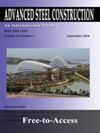冷弯角对高强度钢材料性能的影响
IF 1.7
3区 工程技术
Q3 CONSTRUCTION & BUILDING TECHNOLOGY
引用次数: 1
摘要
本文研究了S650高强度钢材料的性能,包括冷成形角的影响。研究了不同冷弯角度(90°、100°、120°、140°、160°和180°)和不同厚度(4 mm和6 mm)的钢板试件。根据拉伸片试验结果,确定了冷弯角与材料屈服应力和拉应力的关系。将考虑冷弯角影响的屈服应力和拉应力与不考虑冷弯角影响的屈服应力和拉应力进行了比较。分析表明,屈服应力和拉应力随冷弯角的增大而减小。利用有限元分析软件ABAQUS中的韧性损伤材料模型进行拉伸试验模拟。实验结果与数值结果吻合较好。收稿日期:2019年3月19日2019年4月20日2019年5月05日本文章由计算机程序翻译,如有差异,请以英文原文为准。
INFLUENCE OF COLD-FORMED ANGLE ON HIGH STRENGTH STEEL MATERIAL PROPERTIES
This paper describes a study of the S650 high strength steel material properties including the effect of cold -formed angle. Coupon specimens with different cold-formed angles (90°, 100°, 120°, 140°, 160° and 180°) and different thicknesses (4 mm and 6 mm) were examined. Relationships between cold-formed angle and yield stress as well as tensile stress of the material were determined, based on the tensile coupon test results. Yield and tensile stresses assessed by consid ering the influence of the cold-formed angles were compared with those without considering this influence. Analyses revealed that both yield and tensile stresses decreased with increasing cold-formed angle. Ductile-damage material models available in the finite element analysis software ABAQUS were used to simulate tensile coupon tests. The experimental and numerical results showed good agreements. Received: Revised: Accepted: 19 March 2018 20 April 2019 05 May 2019
求助全文
通过发布文献求助,成功后即可免费获取论文全文。
去求助
来源期刊

Advanced Steel Construction
CONSTRUCTION & BUILDING TECHNOLOGY-ENGINEERING, CIVIL
CiteScore
2.60
自引率
29.40%
发文量
0
审稿时长
6 months
期刊介绍:
The International Journal of Advanced Steel Construction provides a platform for the publication and rapid dissemination of original and up-to-date research and technological developments in steel construction, design and analysis. Scope of research papers published in this journal includes but is not limited to theoretical and experimental research on elements, assemblages, systems, material, design philosophy and codification, standards, fabrication, projects of innovative nature and computer techniques. The journal is specifically tailored to channel the exchange of technological know-how between researchers and practitioners. Contributions from all aspects related to the recent developments of advanced steel construction are welcome.
 求助内容:
求助内容: 应助结果提醒方式:
应助结果提醒方式:


